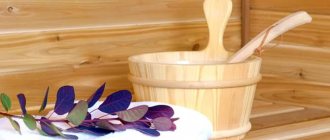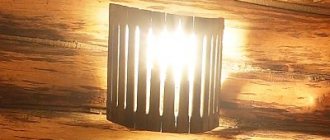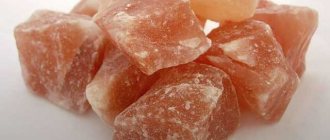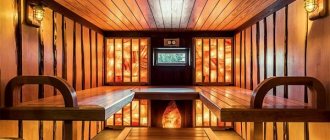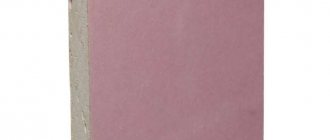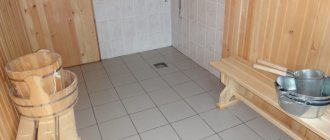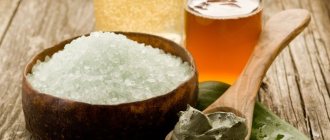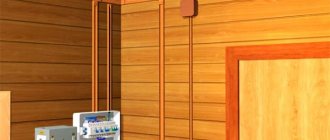A visit to the bathhouse is not only a pleasant pastime, but also a health procedure that helps strengthen the body and cure various diseases. Do you want to increase your health benefits? Himalayan salt is an environmentally friendly substance that has healing properties.
Finishing the sauna with Himalayan salt
An interesting fact is that Himalayan salt and the human body have the same set and the same amount of mineral elements.
When heated in a sauna or bathhouse, salt plates release these elements into the atmosphere of the room. Consequently, when visiting a sauna, a person receives them through breathing and through the skin in a short period of time. The vapors released from Himalayan bath salt normalize blood pressure, metabolism in the body, and calm the nervous system. The iodine released during the evaporation of Himalayan salt has a beneficial effect on the functioning of the thyroid gland. The ability to destroy molecular bonds, so-called “salt deposits” in the human body, makes Himalayan salt an indispensable remedy for the prevention and treatment of cardiovascular diseases (sclerosis, atherosclerosis) and diseases of the musculoskeletal system.
The environmental friendliness and a number of beneficial properties of Himalayan salt have made it a popular material in the design of saunas. As you know, people come to the sauna to improve their health, and the presence of Himalayan salt elements in it contributes perfectly to this. Due to the presence of more than 80 useful elements in Himalayan salt, it is a successful treatment for bronchial asthma, allergic and infectious diseases, diseases of the central nervous system and immune system.
Salt sauna - benefits and healing properties. Composition of Himalayan salt
A salt sauna has a general strengthening effect on the human body. If, instead of a regular sauna, you regularly visit a salt sauna, then the mechanism of rejuvenation and restoration of health begins to work, thanks to increased immunity.
The healing and health-improving effect is determined by the rich chemical composition - 84 elements out of 200 possible chemical elements from the periodic table were found in the structure of salt crystals. All these elements that make up Himalayan salt are almost completely preserved during extraction and processing and are useful for humans.
The maximum effect and the greatest release of microelements from salt occurs when it is heated to 60°C in a sauna (humidity should not exceed 74%). The main trace elements of Himalayan salt: copper, potassium, magnesium, calcium, iron. These substances in the human body are responsible for hematopoietic function, brain activity, the condition of nerve and muscle fibers, regulate blood pressure, metabolic processes and many other vital functions.
– diseases of the respiratory tract and oral cavity – nervous disorders and insomnia – cardiovascular diseases, including hypertension – diseases of the joints and musculoskeletal system – diseases of the skin, including manifestations of allergic reactions (pimples, acne, purulent wounds, etc.) – allergies – diseases of the genitourinary system – metabolic disorders
Staying in salt saunas is recommended for people with various pulmonary diseases: bronchitis, asthma, pneumonia, rhinitis. The bactericidal properties of this salt are good prevention against colds, infectious diseases, sinusitis and sore throat. A salt sauna is useful for people who have undergone surgery on the lungs and respiratory tract.
The air in the salt sauna, equipped with elements from Himalayan salt, saturates the body of the person in it with barium and sodium, which are extremely beneficial for him. Thanks to salt sources, harmful molecular bonds in the form of salt deposits and sclerosis are destroyed in the human body. Himalayan salt stabilizes blood pressure, relieves depression, giving a positive psychological outlook.
Ancient Indians also used Himalayan salt to prevent oral diseases. Women who want to keep their skin youthful also use Himalayan salt to nourish the skin and improve its elasticity. Thanks to Himalayan salt, chronic fatigue syndrome, which is difficult to cure with traditional medicine, is eliminated in humans.
In our conditions, the construction of walls and entire buildings from this material is, of course, prohibitively expensive, while the use of Himalayan salt as individual elements can significantly improve the microclimate of the room. This natural material was created by nature hundreds of millions of years ago, when the ecology was a priori clean.
The use of salt elements specifically in saunas and baths is recommended by scientists because the evaporation of beneficial microelements and ions from Himalayan salt minerals becomes maximally active with increasing temperature. Today, saunas with Himalayan salt in the countries of the Old World are a 100% profitable business - registration is required for such baths or saunas... demand exceeds supply.
For the construction of saunas from Himalayan salt and the use of this natural material as an additional material, the modern construction industry offers several types of building materials.
These are salt bricks, salt pebbles, polished tiles and blocks, which can be unprocessed on one side (one natural side) to give more grace to the wall being built - for clarity, go to the photo section. Brick is a more expensive material than salt tiles, but it is also much more durable.
An important point is paving the floor with salt bricks! This option for decorating saunas and dressing rooms is successfully used by designers. This is due to the fact that Himalayan salt, as such, is an antiseptic material, so you can absolutely safely be in saunas with a salt floor without slippers, barefoot.
Can it harm
Like any type of this mineral, Himalayan salt is harmful only in excess quantities. Its evaporation does not have a negative impact - you can at least build a bathhouse entirely from salt bricks. But you should consume salt internally in moderation: it still contains sodium chloride, albeit in relatively small quantities (from 15% to 20%).
Contraindications for interaction with Himalayan salt:
If you have any of the above problems, you must refrain not only from using Himalayan salt, but also from bath procedures in general. Its use should also be avoided if you have an intolerance or hypersensitivity to sodium chloride.
You should be wary of low-quality fakes. Often, under the guise of real salt from the Himalayas, they sell rock or sea salt, tinted pink. Such a counterfeit can harm the body due to dye fumes.
Installation of Himalayan salt in the sauna
To make the connection of salt blocks and bricks more durable, it is necessary to use a special composition - a mixture of caustic magnesite and magnesium chloride in the correct ratio. Salt is diluted in water, after which magnesite is added. It is important to remember that the finished mixture dries quite quickly. For 1 m² of salt blocks five centimeters thick, about a kilogram of mixture is required.
The process of setting blocks takes no more than 4 hours. In order not to spoil the aesthetics of the salt blocks, the mixture must be applied extremely carefully - it has a dark gray color, which does not look particularly beautiful against the background of red-orange and pink blocks if the solution is used excessively. Sometimes liquid glass* is used as an adhesive solution, but the strength of such masonry is significantly lower than when using a magnesite mixture. There is also a special glue for Himalayan salt.
There is another less well-known and labor-intensive method of installing Himalayan salt on brackets - a glue-free bracket system for unloaded installation of salt slabs for cladding flat surfaces. The versatility of the system lies in the fact that one wall bracket made of stainless steel 1 mm and 1 m long distributes the load of only 5 salt plates 200x100x50, and the system itself can be built to any size, both in width and height.
Video description
For little tricks you need to know when using a wall made of Pakistani salt, watch the following video:
Building a wall
A load-bearing structure made of vertical metal profiles is first mounted on the walls, and horizontal gutters are already installed on them. The tile itself is inserted into these grooves like a panel.
Sauna owners most often choose this method of fixing salt stones for a bath; using fastening glue is considered not a completely reliable method.
However, a special glue based on salt itself and caustic magnesite is used to glue the blocks. They are mixed with water in a ratio of 5:3 or 3:2. The resulting glue is used immediately, within 10 minutes, as it dries very quickly.
For those who do not want to prepare glue themselves, two-component dry adhesive mixtures are sold, which are diluted in water and are used up just as quickly.
After the wall is completely assembled and its individual blocks are glued together, you should exclude the slightest drafts in the bathhouse for a day until the wall is completely dry, although the glue itself dries in 4 hours.
As an alternative to such a traditional adhesive composition, liquid glass can be used for salt and briquette baths. However, when using such a cheap substitute, the assembled wall will not be very strong.
Backlight
It’s good when daylight penetrates through the partition, because in this case additional lighting will not be needed.
It's another matter when the wall is covered. In this case, it is extremely important to highlight the entire wall. Light penetrating through the salt bricks will diffuse a soft and warm orange light throughout the room.
Here are just a few of the requirements for electric lighting on a wall made of Himalayan pink salt:
- The wiring must withstand high temperatures, because it is possible that it will pass next to the hottest wall, where the temperature can reach hundreds of degrees;
- Another important factor is moisture, which has an extremely negative effect on electrical circuits and devices. Therefore, it is best to take care of purchasing moisture-resistant components in advance.
- Availability. No matter how good the wiring itself is, it may require inspection, albeit visual, or even repair. Therefore, it is better to lay it in such a way that in the future you do not have to disassemble the entire salt wall to inspect the cable insulation.
- LED strips are best suited for lighting. They consume little current and are less demanding on the environment.
Basic principles
In order to make a backlit panel in the steam room, you need to leave a gap of 3-6 cm between the bricks (tiles) and the wall in which the light sources will be located. This gap is necessary, firstly, in order to somehow position the light sources behind the salt, and secondly, so that there is the necessary space for the spread of reflected light. Why exactly reflected? The fact is that if you simply place a powerful light source, it will shine brightly only in one place, that is, it will be point-like. We need to create as uniform illumination as possible. This is achieved only through reflection and re-reflection. The light will be reflected from the foil or film located behind the light sources; be reflected - from the inner surface of the salt itself. How brightly the panel will glow depends on:
- power of light sources;
- the effectiveness of their reflection;
- the thickness of the panel itself.
Everything is clear with the first two points, but what about the thickness? Depending on whether you choose tile or brick, your design will be different.
You can choose a lighting option based on the criterion of replacing light sources: either the element itself is located directly behind the salt, or it is located in another place. Sources that are behind the salt - LED strips (tubes), incandescent lamps; outside the panel there is a projector with an LED that illuminates the panel through an optical fiber. Accordingly, to replace the LED strip, you will need access to its installation site. There are two access options: behind the wall or in front, i.e. dismantling the wall. In the case of fiber optics, the projector must be replaced, which may be located outside the steam room, or under shelves (with a service life of 50,000 hours, this is unlikely to be necessary).
Types of illuminated walls
Installation of brick panels using Himalayan salt adhesive
This installation method, in our opinion, is the most preferable: we get a monolithic structure that will hold securely and will not require further maintenance.
With this installation method, it would, of course, be appropriate to use a fiber optic kit with the projector. If you choose an LED strip or tube, you will need to organize access behind the wall (if possible), or accept the fact that when the strip (tube) burns out, the wall will no longer be illuminated.
You can purchase adhesive composition for salt products from anyone who sells Himalayan salt. It is usually mixed with water in a certain proportion, and does not set immediately. After this composition has completely hardened, your wall becomes monolithic. It is important to note that when using bricks, you most likely will not need to prop up the wall while it dries, since the salt brick will be held up due to its width. To fix it in a horizontal plane in the room being used, it is necessary to use support strips from the inside and layouts from the outside.
The finished version looks like this:
Installation of tile panels using Himalayan salt adhesive
Unlike brick, tiles will most likely not hold up when the mortar dries, so the structure must be supplemented with temporary support. You will also need constant support, because even after the mortar has completely set, a tile wall will not be as stable as a brick wall. As a permanent support, you can use a large metal mesh on which the panel will rest.
It is also necessary to provide for attaching the salt panel to the mesh, because we do not have any support in front. In the photo, the salt tile is tied with a nylon thread threaded through a mesh, i.e. we actually tie our panel to a grid, as a result of which it is fixed in space.
Recommendations for the light source are the same as in the first paragraph.
The result will look like this:
"Dry" installation
In our opinion, the least justified type of installation is associated with a number of inconveniences and further maintenance.
I’ll say right away that due to the complexity of maintenance and the unsuitable quality of the source material, we currently do not use this type of installation.
For dry installation you will need aluminum profile guides. Salt products will be installed on them. The guides themselves are attached to the wall through pieces of rectangular aluminum profile. An LED strip or tube is laid in this space.
I note that “dry” installation should be used only if it is not possible to organize access to the backlight from the other side and an LED strip or tube is used as a light source. When using optical fiber, there will be access to the light source because the projector is not behind the salt wall.
To install bricks (tiles) on the profile, you need to make grooves in the bottom and top of the tile.
Since there is no mortar in this design, there are no seams between the products, so each tile must correspond to the stated dimensions and have right angles. In practice, this is observed for a small proportion of products, resulting in the need to adjust each product, which significantly increases the overall installation time.
Selecting a light source
Fiber Optic Spot Lighting
The most suitable option, in our opinion.
It does not require replacement of lamps (the service life of the LED in the projector is 50,000 hours).
The fiber can withstand temperatures up to 180 °C.
You can vary the brightness of the lighting by the number of points used per meter.
There is only one drawback - the relatively high cost.
Linear fiber optic lighting
The most expensive option.
Due to the design features, it will not be possible to install it everywhere, because... The fiber length of all rulers is the same, and the rulers themselves are installed at different distances from the projector.
Withstands lower temperatures than dots (80 °C).
LED tubes
We are talking about tubes from manufacturers of sauna equipment.
They have a protective box, which makes it possible to operate them at high temperatures.
After the tube burns out, it needs to be replaced.
The tubes have a set of fixed lengths.
LED strips
Such tapes are produced, among other things, by manufacturers of equipment for the construction of saunas. They have a protective shell, thanks to which they can be used at high temperatures.
After burnout, they require replacement.
Despite the protective sheath, such tapes are still not designed to withstand the same high temperatures as optical fiber.
Incandescent lamp
Yes, yes, an ordinary light bulb. But it is installed, of course, not behind the stove where the panel is mounted, but behind this lampshade made of Himalayan salt:
Briefly about the main thing
Pink Himalayan salt is ordinary table salt that is mined by hand in one of the Pakistani mines. It is used as a seasoning for food, in cosmetology, and as a cooking surface for cooking. Bath salt can be used in a steam room, both when decorating saunas and steam rooms, and to create a “salt” atmosphere inside the sauna. The health-improving effect of using this finishing material is questionable and remains on the conscience of the bathhouse owner himself, but its harmlessness has been absolutely proven.
The walls are tiled with tiles or salt blocks, and backlit with lamps or LEDs. First, a load-bearing profile is constructed, and the blocks are inserted into it like a typesetting panel. You can also limit yourself to simple masonry using homemade or factory-made glue based, in fact, on salt and magnesite itself.
You can also make lamps, panels, sun loungers from Himalayan halite, lay out paths in a bathhouse, and use them as stove stones.
Source
What is a salt wall for?
Installing Himalayan salt blocks makes sense for several reasons:
✔ Beauty It’s hard to argue with the fact that salt blocks are a truly beautiful material. They fit perfectly into any interior. A structure made of salt bricks with lighting looks especially impressive, but you can make a wall or panel without installing LEDs: you can choose the option that is more preferable for you.
✔ Convenience A salt wall can serve as a partition in a room, dividing it into two parts or rooms. In addition, it is convenient to lean on it during water treatments in a bathhouse or sauna.
✔ Beneficial effects on health The composition of Himalayan salt is similar to table salt, but additionally contains many mineral impurities. It is thanks to these impurities that the use of salt bricks or tiles in baths and saunas is so widespread. The fact is that when Himalayan salt is heated, the air is saturated with negative ions, as well as the microelements it contains, which strengthens the immune system and helps improve well-being.
Installing a wall made of Himalayan salt in a sauna or bathhouse can be done in two ways: glued and glueless.
Precautionary measures
Before we begin to describe in more detail how to use Himalayan pink salt in a bath, we should say a few words about in what cases it is best to use it.
Salt's worst enemy is water. Exposure to moisture gradually destroys it; in other words, water will sooner or later completely dissolve all the salt. Since this usually happens from the bottom up, it is possible that the wall will collapse on the heads of the guests.
Therefore, the main rule on how to properly use salt in a bath as a decoration is no moisture. It is best if it is a dry Finnish sauna; a traditional Russian bathhouse is not suitable for these purposes. It is in the sauna that you can achieve the lowest humidity value for this type of room - 55%.
The next point is sufficient ventilation. In order for the moisture to evaporate as quickly as possible, without having time to react with the salt blocks, it is necessary to ventilate the premises well after guests have used the sauna.
How to glue salt tiles or bricks
If you have chosen the adhesive method of installing salt walls made of tiles or bricks, remember: it must be done only with special glue. It allows the structure to be firmly fixed to bases made of wood, brick, concrete and other materials, and, importantly, contains substances that prevent the formation of mold and mildew. In this case, it is necessary to mix the glue strictly according to the instructions: only then will it be resistant to changes in temperature and humidity for many years. It must be applied to clean, dry surfaces using a comb spatula.
Lamp
As a rule, lamps made from pieces of salt are factory-made, and bathhouse owners most often go to the store to buy a ready-made product, although you can make it yourself.
The easiest way to use Himalayan salt in a bathhouse is to secure a wooden basket in a pre-selected place in the bathhouse, into which salt is poured in the form of small pieces or coarsely ground pebbles. An ordinary light bulb (preferably LED) of a warm color is attached to the inside of the basket for illumination. This option is the most budget-friendly option for a lamp made from Himalayan pink salt.
A somewhat more complex and expensive, but also more advantageous way to use salt tiles for a bath is to create a full-fledged portable lamp from Himalayan salt tiles. To do this, the tiles are laid in a special way - in the form of a box without a bottom. Individual tiles can be secured to each other either using special glue or with clamps made of metal or any other durable material.
The assembled lamp must be mounted on a base made of wood or plastic, made in the form of a regular plate (for example, a sheet of plywood). The socket with the lamp is also brought from below and fixed to the base so that the lamp itself does not touch the walls of the lamp.
Features and advantages of glueless installation
Glueless installation of bricks or tiles made of Himalayan salt in a bathhouse (or in other rooms) has the following advantages:
✔ A variety of location options Using special profiles for glue-free fastening of salt tiles, you can install it anywhere without fear of collapse.
✔ Easy installation of lighting When planning to install a salt wall, many consider options only with heat-resistant lighting. Indeed, this is an excellent choice, because the heterogeneous structure of Himalayan salt bricks or tiles allows you to get a very beautiful pink or orange light. However, when installing with glue, it is often difficult to install the backlight behind the tile or brick, because in this case additional distance is required between the blocks and the base, which will negatively affect the stability of the wall. These problems are easily solved by glueless installation: when used, the structure will be as durable as possible, both without LEDs and with them.
✔ Easy installation and dismantling When using connection and end profiles for Himalayan salt, no preliminary preparation is required. All you need to have is heat-resistant diode strip, a screwdriver, self-tapping screws and, of course, tiles or bricks with grooves. The resulting structure can be used both permanently and temporarily: if necessary, it can be easily disassembled without damaging the blocks (this is impossible with adhesive installation). The wall, installed using glueless installation, can be used at exhibitions or in rented premises: you can easily disassemble it as soon as necessary.
✔ Maintainability. In fact, this advantage is a consequence of the previous one. If the backlight fails during the operation of the salt wall, you will not have to break several rows of bricks or tiles.
If you still have questions about how to use Himalayan salt bricks and tiles to create a wall in a bathhouse or sauna, you can always contact our staff. We will be happy to answer your questions in detail and help you select all the necessary materials.
Bathhouse projects
It is no longer enough for today’s owners of private houses to simply build an ordinary bathhouse; they also want to somehow stand out from the general gray mass. You can, of course, build some kind of medieval “tower” or install an original cast-iron lattice in the form of a fence. However, you don’t have to take such radical steps and first practice… decorating. Even a classic building can literally sparkle with new colors if you decorate one of the walls with original material. We are talking about Himalayan bath salt and how to use it in a steam room.
Beneficial properties of Himalayan salt
The beneficial properties of Himalayan salt are due to the presence of a large number of minerals and trace elements. Staying in such a steam room is akin to relaxing at sea. As temperature increases, the rate of ion evaporation increases. Vapors saturated with negatively charged particles have a general strengthening effect, have a positive effect on hematopoietic function, brain activity, the nervous system, muscle condition, stabilize blood pressure, improve the condition of the upper respiratory tract, relieve depression, and relieve fatigue. Inhalation of dry ionized air is the treatment and prevention of colds and skin diseases (dermatitis, eczema), various forms of allergies.
Sodium and potassium nourish and cleanse cells, calcium promotes blood clotting and wound healing; Magnesium plays an indispensable role in the aging process of the body. Iodine normalizes hormonal processes; manganese, zinc, selenium increase immunity, preventing the formation of tumors. Iron and copper – prevention of anemia, silicon – strengthening of blood vessels.
Recommendations and restrictions on the use of salt in finishing
Installation of Himalayan salt in the sauna
The blocks are connected with a special composition consisting of magnesite and magnesium chloride. To obtain glue, mix 3 parts of magnesite and 5 parts of magnesium chloride. The adhesive composition is carefully applied to the material. Setting time is about 4 hours, complete drying is 18-20 hours.
A connection with liquid glass is allowed, but the strength will be worse.
There is a special glue on sale that contains antiseptic additives.
The glue is moisture and heat resistant, non-toxic, odorless, and dries quickly. Glueless hidden installation involves attaching stainless steel brackets to the sheathing.
The material is processed by hand and given the desired shape. Additional cuts allow it to be inserted into the profile along special grooves. The contact area of the material with air increases by 2.75 times compared to adhesive installation. The pressure of the supporting structure is only 55 kg per square meter. Undeniable advantages of the method:
- Installation at any height.
- Increasing the area of interaction between salt and air.
- Construction of structures vertically, horizontally, at an angle.
- Installing lighting between the structure and the tiles.
- Laying out a variety of patterns from tiles of different thicknesses and textures.
- Replacement of individual elements without complete dismantling.
Himalayan salt: what is it, areas of application
The formation of pink crystals occurred about 250 million years ago as a result of tectonic movements of the earth's crust between India and Eurasia. Volcanic activity led to their mixing with magma and rising from the ocean floor.
The Khewra mine produces about 325 thousand tons annually. It is mined by hand and dried in the sun.
The presence of useful substances (sodium chloride, potassium, calcium, iron, magnesium, iodine, fluorine, selenium, manganese, bromine and others), mining in an ecologically clean area allows the mineral to be used in medicine, cosmetology, and cooking.
Himalayan salt is a whole complex of minerals.
Knowing its antibacterial properties, it was scattered in the tombs of the pharaohs. Today, a large medical complex operates at the salt mines, where asthma is successfully treated. Treatment is carried out deep underground in specially equipped rooms. Due to its medicinal properties and decorative capabilities, halite has found wide use in construction. The cladding of stoves, walls, individual elements, panels, candlesticks - this and much more create not only a unique atmosphere in the steam room, but also allow you to spend time with great health benefits.
The installation of halogenerators - devices for spraying salt - increases and consolidates the therapeutic and prophylactic effect several times. Interestingly, smokers have a decreased or completely lost desire to smoke.
Contraindications to visiting such a sauna are individual intolerance, fever, acute illnesses, serious diseases such as malignant tumors, thrombophlebitis, blood and kidney diseases. It is indispensable for restoring health, preventing and strengthening the immune system.
